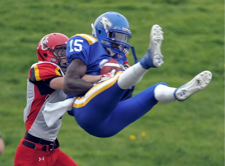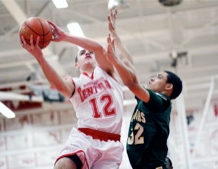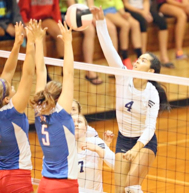Behind the catches, interceptions, tips, tackles and returns are some of the most commonly reported sports injuries in football, as well as other fall and winter sports – finger injuries.
Finger injuries actually represent one of the most common body injuries in sports in general and include sprains, dislocations, tendon damage and fractures. They are very common in football, basketball and volleyball.
Rarely does a finger injury go unnoticed. They can be very painful and more challenging to heal, as our hands are constantly in use in everyday activity.
Some of the most common causes of a finger sports injury include:
- Struggle to maintain (as well as strip) a football
- Clashes with teammates and opponents
- Awkward and sudden impact with a ball
- Catching or pulling on a jersey
- Falls onto a hard surface
Finger sprains generally represent damage to the collateral ligaments, which are band-like structures that stabilize the finger and prevent side to side movement. It most frequently occurs in the mid finger. The little finger, middle finger and thumb are the fingers most affected in such injuries.
A finger sprain can vary in severity and is graded on a scale of 1-3. Grade 1 represents the mildest type of sprain, a stretched ligament. Grade 2 is a partially torn ligament, and Grade 3 represents one that is completely torn. When a Grade 3 finger sprain is sustained and bones are also out of place, altering joint surface contact, it is diagnosed as a finger dislocation.
A finger dislocation may be identified as an MCP (metacarpophalangeal), DIP (distal interphalangeal) or PIP (proximal interphalangeal) dislocation depending on the finger joint and bone it affects.
Finger sprains are also often referred to as a “jammed finger.”
Depending on the severity of a “jammed finger,” symptoms may include:
- Pain and immediate swelling
- Bruising and pain during activity
- Impaired function
- Deformity
- Stiffness and difficulty during gripping activity
Tendon Injuries
Tendons in the hand are tissues connecting muscle to bone, which when contracted pull on bones causing fingers to move. These muscles moving the fingers and thumb are located in the forearm – long tendons extending through the wrist and attaching to the small bones of the fingers and thumb.
The tendons on the top of the hand straighten the fingers and are known as extensor tendons. Those on the palm side bend the fingers and are known as the flexor tendons.
When fingers are bent or straightened, the flexor tendons slide through snug tunnels, called tendon sheaths, keeping the tendons in place next to the bones. A tendon rupture disrupts this natural flow.
A relatively common tendon injury of the hand diagnosed in fall sports is a tendon rupture, also called a “Jersey Finger.” This occurs in a “tear-away” type of activity, such as grasping a jersey with finger(s) in a flexed position – and then forced straight as the player quickly moves in another direction. The result is loss of flexion at the DIP joint because of damage to the flexor tendon.
An injury to the tip of the finger may result in extensor tendon damage, which is also known as a “Mallet Finger.”
Symptoms of a flexor or extensor tendon rupture may include:
Flexor
- An inability to bend one or more joints of your finger
- Pain when your finger is bent
- Tenderness along your finger on the palm side of your hand
- Swelling of the finger
Extensor
- Inability to open or extend the hand or fingers
- Pain
- Swelling or weakness of the finger
- Cut to the back of the hand or fingers
Finger Fractures
Among the more severe finger injuries occurring in sports are finger fractures. This is a break in one of the small bones of the finger. Finger fractures may be stable or unstable. Among the most common finger fractures include; distal phalanx (also known as a Tuft Fracture and associated with “crush” injuries), mallet, flexor digitorum profundus avulsion, and middle and proximal phalanx fractures (non-displaced, unstable, or displaced – which are usually more complex fractures to treat).
The correct diagnoses and treatment of a finger fracture, which can often mimic a finger sprain or dislocation in pain and symptoms, is imperative in ensuring optimal long-term function.
DIAGNOSIS
While many finger injuries can be diagnosed with a physical examination, an x-ray is indicated to more thoroughly assess the injured area or possible fracture – and severity of the injury. A CT scan may also be used to evaluate complex fractures. An MRI is often used when the soft tissues are involved (such as with tendon ruptures).
TREATMENT
Treatment for most finger injuries is nonsurgical, conservative approach that may involve RICE (rest, ice, compression, elevation), splinting, anti inflammatory medications for swelling/pain, and rehabilitation exercises. Reduction may be performed on some simple fractures and supported with splinting or “buddy taping” (practice of taping the injured finger to a nearby uninjured finger to limit mobility and provide splint-like support).
More serious injuries and those unresponsive to conservative treatment may require surgical repair and an aggressive post-surgical hand and upper extremity therapy program.
PREVENTING INJURY
Injury prevention is always preferable for athletes wanting to give it their all during the sports season. There are some things you can do to reduce risk of injury during sports this fall and the seasons to come:
- Avoid wearing rings or other jewelry when playing.
- Opt for closed fist rather than open hand approaches in volleyball and blocking in football.
- Buddy taping (as mentioned above) can also be effective in preventing finger injury in a number of different sports.
- Finger bracing should be worn in both practice and games until symptoms of a mildly injured/painful finger resolves, to avoid more serious injury/damage.
- Finger and hand strengthening exercises can be beneficial.




Comments are closed.